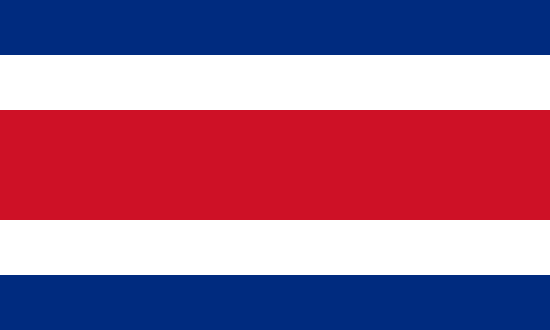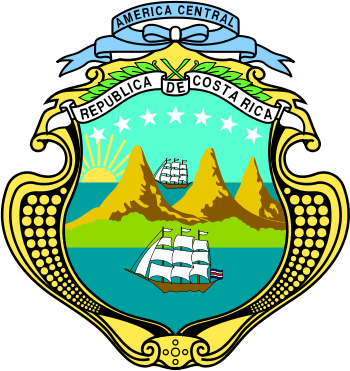Costa Rica is located in Central America, between Nicaragua and Panama, and is a fascinating destination. There are pristine rainforests, active volcanoes, an impressive diversity of animal and plant species and countless sandy beaches facing both the Caribbean Sea and the Pacific Ocean.
| Capital: | San José |
| Biggest city: | San José |
| State: | republic |
| Language: | Spanish |
| Religion: | catholicism |
| Surface: | 51 100 km² |
| Population: | 4.7 million (2013) |
| Population density: | 83 residents per km² |
| Life expectancy: | 78 years |
| Illiteracy: | 5% |
| Currency: | colon (CRC) 1 colon = 0.01 kr |
| GDP per capita: | $ 10,700 (2010) |
| Time difference: | -7 hours |
| Electricity: | 110/220 V AC 60Hz |
| National Day: | September 15 |
| Country area code: | 506 |
| 2-Letter country abbreviation: | CR(See more abbreviations on Abbreviationfinder) |
| Business: | service sector 57%, agriculture 25%, industry 18% |
| Climate: | tropical with rainy season from May to November |

It is the most prosperous country in Central America. The economy is largely based on tourism, and especially ecotourism. The country has a strong nature protection, and in this respect is considered a pioneering country.
It is one of the smallest countries in the world in terms of surface area, but also one of those with the greatest biological diversity. Despite the country’s small size, five percent of the world’s species can be found here. 27 percent of the country’s area is set aside for national parks, nature reserves, nature conservation areas or some other form of protected area.
Like many other Central American countries, ancient Mayan and Inca cultures have shaped Costa Rica’s history. The oldest settlements date back 10,000 years. The name costa rica, “the rich coast”, is said to have been used by Christopher Columbus who arrived in present-day Costa Rica in 1502. The
people like to identify themselves as the opposite of the rest of Central America: they are not illiterate, poor or living in any political chaos. Instead, they like to emphasize the country’s high standard of living and its national parks. The country abolished its military in 1948, and has done well without an army for over half a century.
Roads in Costa Rica are mostly paved, and generally better than in the rest of Central America. Most major cities can be reached by car or bus.
WORLD HERITAGE
The following objects in Costa Rica are listed as a UNESCO World Heritage Site.
The year in which the item was added to the list is indicated in parentheses.
| Talamanca Range-La Amistad Reservation / La Amistad National Park (1983) |
| Cocos Island National Park (1997) |
| Guanacaste Nature Reserve (1999) |
| Stenkloten i Diquís (2014) |
ELECTRICAL OUTLET
Electricity and electrical outlets in Costa Rica
Voltage: 120 V
Frequency: 60 Hz
Type of plug: A, B
Need an adapter: Yes, Swedes need an adapter.
CLIMATE AND WEATHER
Weather in San José
| Climate | Jan | Feb | Mar | Apr | May | Jun | Christmas | Aug | Sep | Oct | Nov | Dec |
| Average temperature °C | 28 | 29 | 30 | 30 | 29 | 28 | 28 | 28 | 28 | 27 | 27 | 28 |
| Day °C | 34 | 35 | 36 | 37 | 35 | 33 | 33 | 33 | 32 | 31 | 32 | 33 |
| Night °C | 23 | 23 | 23 | 24 | 24 | 24 | 23 | 23 | 23 | 23 | 23 | 23 |
| Rain (mm) | 1 | 7 | 8 | 34 | 248 | 269 | 202 | 246 | 371 | 366 | 125 | 11 |
| Rainy days | 23 | 23 | 23 | 24 | 24 | 24 | 23 | 23 | 23 | 23 | 23 | 23 |

San José
According to Countryaah, San José has been the capital of Costa Rica since 1823. The city has 341,000 residents (2005) in the central city and 2,115,000 residents (2005) in the entire metropolitan area.
San José is located in central Valle, about 1170 meters above sea level, and is surrounded by high mountain peaks. The city has mainly low-rise buildings with a few exceptions around the commercial parts in the center. Despite its problems, San Jose is still one of Latin America’s safest and least criminal cities.